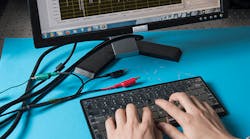A self-powered keyboard developed at the Georgia Institute of Technology can charge up electronic devices and prevent unauthorized persons from accessing the computer.
The new keyboard consists of stacked, transparent films. It starts with a layer of polyethylene terephthalate sandwiched between a top and bottom layer of indium tin oxide (ITO), and the outer layers act as electrodes. A layer of fluorinated ethylene propylene (FEP) is applied to the top ITO layer and nanowire arrays are etched into it. The FEP lets the top layer generate electricity through the triboelectric effect when touched by a person’s fingertips. (In the triboelectric effect, charge is created when materials are brought together and then moved apart.) Contact electrification is also in play. It generates current when the user’s fingers touch the plastic layer coated with electrode material.
These films let the keyboard operate based on coupling between contact electrification and electrostatic induction rather than traditional mechanical switching. So when a finger contacts the FEP, charge transfers at the contact interface, injecting electrons from the skin into the FEP material and creating a positive charge. When the finger moves away, negative charges on the FEP side induces positive charges on the top electrode and equal amounts of negative charges on the bottom electrode. Consecutive keystrokes produce a periodic electrical field that drives reciprocating flows of electrons between electrodes. Typing creates enough electricity to charge a small, portable device or power a transmitter and make the keyboard wireless.
The keyboard registers which key was struck as well as the amount of force applied to the key, and the length of time between one keystroke and the next. Research indicates that these parameters are unique to an individual’s style of typing and they could provide another biometric for securing computers and other devices from unauthorized use.
Researchers say the new keyboard is constructed from inexpensive materials widely used in the electronics industry and future versions will be competitive with conventional keyboards in terms of cost and durability. For example, the keyboard’s construction makes it impervious to most liquids, such as soda and coffee.
